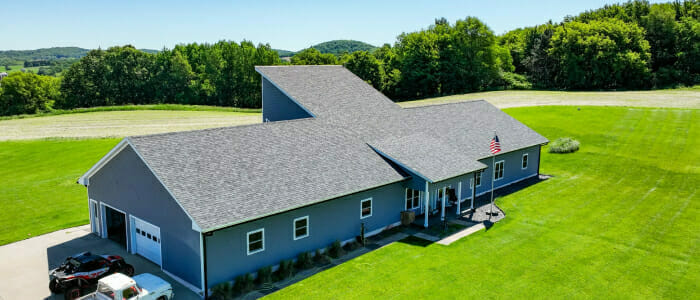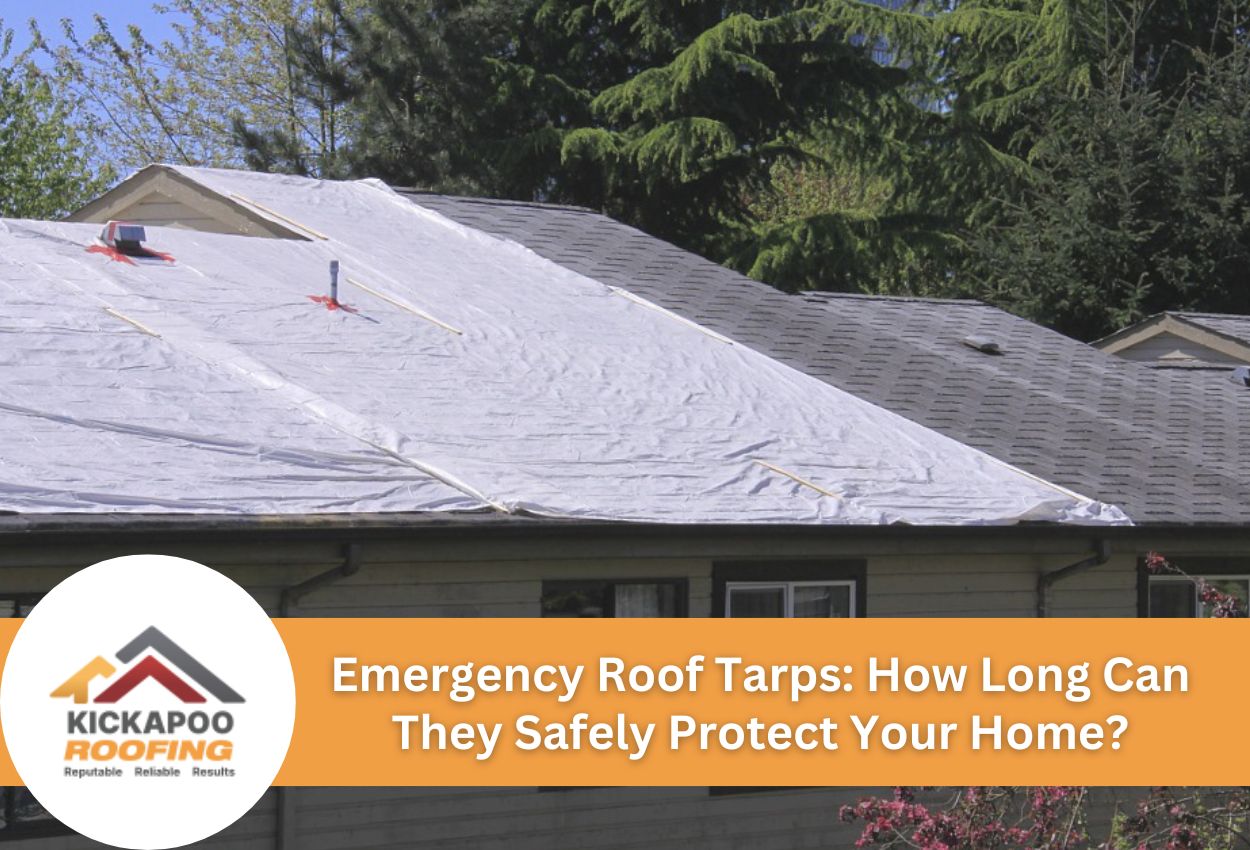When storms strike across Wisconsin, Iowa, and Minnesota, emergency roof tarps often become the first line of defense against water damage. These blue plastic shields serve as crucial temporary protection for homes with damaged roofs, buying homeowners valuable time to arrange permanent repairs. But exactly how long can you rely on that emergency tarp before it becomes ineffective or potentially dangerous?
Most emergency roof tarps are designed to last between 90 days and six months under typical weather conditions. However, this timeline can vary significantly based on several important factors, including the quality of the tarp installation, the severity of your local weather conditions, and the type of tarp material used.
While the immediate goal of installing an emergency roof tarp is to prevent further interior damage to your home, understanding its limitations is essential for protecting your property long-term. A properly installed emergency tarp provides valuable breathing room to contact insurance companies, get estimates, and schedule permanent roofing repairs, but it should never be viewed as a long-term solution.
For homeowners dealing with storm damage, knowing the appropriate timeline for roof tarp removal and permanent repairs helps prevent secondary damage that can occur when temporary solutions are relied upon for too long.
Understanding the Lifespan of Temporary Roof Protection
The durability of emergency roof tarps varies significantly depending on the materials used. Standard blue tarps typically offer protection for 30 to 90 days, while higher-quality reinforced options might extend that timeline to six months under ideal conditions. The thickness of the tarp, measured in mils, directly impacts its longevity. Thicker tarps (10 to 12 mils) generally outperform thinner options (5 to 6 mils) when facing Wisconsin, Minnesota, and Iowa’s challenging weather patterns.
Manufacturer recommendations generally suggest a maximum duration of 90 days for most temporary roof coverings. However, experienced roofing contractors across the Midwest consider these timelines to be absolute maximums rather than optimal durations. The harsh reality is that even the most durable emergency tarps begin degrading from the moment they’re installed.
While manufacturers may claim longer lifespans under perfect conditions, real-world performance in our region’s climate typically falls short of these estimates. Wind-driven rain can work its way under even professionally installed tarps after repeated exposure, and the freeze-thaw cycles common throughout our service area accelerate the deterioration of temporary coverings. For homeowners in our region, treating these emergency solutions as truly temporary, ideally less than 60 days, provides the best protection for your property.
From Emergency Fix to Permanent Solution: Creating a Timeline
After installing an emergency roof tarp, developing a realistic timeline for permanent repairs is the next step. The transition from temporary to permanent protection requires careful planning, especially considering the variable weather conditions across Wisconsin, Iowa, and Minnesota. Most roofing professionals recommend beginning this process immediately after the tarp installation, even though the actual process may take several weeks to complete.
Start by contacting your insurance company within 24 to 48 hours of discovering roof damage. Documentation is essential, so take photographs of the damage before and after tarp installation. While waiting for the insurance adjuster to assess the damage, begin researching and contacting reputable roofing contractors in your area. Many Midwest roofing companies offer free inspections and can provide detailed estimates for your insurance claim.
Be aware that contractor availability fluctuates seasonally across our region. After major storms, wait times can extend from days to weeks as demand surges. Winter weather in northern states can also impact repair schedules, potentially extending the time your home relies on temporary protection. Ideally, your emergency roof tarp should be replaced with permanent repairs within 30 to 60 days, though this timeline may stretch during peak seasons or severe weather events.
Remember that the longer a tarp remains your primary protection, the greater the risk of secondary damage. Creating and following a structured timeline helps ensure your emergency roof tarp serves its purpose without becoming a long-term liability.
Seasonal Considerations for Roof Tarps in the Midwest
The effectiveness of emergency roof tarps varies with the changing seasons across Wisconsin, Iowa, and Minnesota. During winter months, tarps face the added burden of snow, which can cause pooling, sagging, and eventual tearing. Snow accumulation exceeding 4 to 6 inches should be carefully removed from tarped areas to prevent collapse. Additionally, frigid temperatures can make tarp materials brittle and more susceptible to cracking, potentially reducing their effective lifespan compared to warmer months.
Summer brings different challenges, as intense UV radiation degrades plastic tarps rapidly in our region. The sun’s rays break down the polymers in standard blue tarps, causing them to become thin and fragile within weeks of continuous exposure. High winds that frequently accompany summer thunderstorms can catch loosened tarps, creating “sail effects” that tear away securing points and compromise protection.
To extend the tarp’s life, consider seasonal reinforcement techniques. During winter, additional securing points help distribute snow weight more evenly. In summer, UV-resistant tarps or adding a reflective cover over standard tarps can significantly extend their usefulness. Inspections after storms are also important — look for signs of water infiltration, sagging areas, or torn edges that indicate your temporary solution is failing. Remember that seasonal extremes make the general 90-day maximum guideline even more critical to observe in our region.
Warning Signs Your Emergency Roof Tarp Needs Immediate Attention
Even the most professionally installed emergency roof tarps will eventually show signs of wear and failure. Knowing when your temporary protection is compromised can prevent extensive interior damage to your Wisconsin, Iowa, or Minnesota home. The most obvious visual indicators include tears, punctures, or sections that have completely pulled away from the roof surface. If you notice your tarp shifting position or developing ripples where it was previously flat, these changes indicate it is failing.
Pooling water on top of your tarp is particularly concerning. This extra weight stresses the material and fastening points while creating perfect conditions for leaks to develop. During inspection, pay special attention to the edges and corners where wind typically begins lifting the material. Discoloration or brittleness of the tarp material signals UV degradation that severely compromises its waterproofing ability.
Less obvious warning signs often appear inside your home before the tarp visibly fails. New water stains on ceilings or walls, especially after rainfall, indicate that moisture is bypassing your temporary protection. Inspect your attic regularly for damp insulation, condensation on rafters, or musty odors that suggest moisture infiltration. The development of mold or mildew anywhere in your home after tarp installation warrants immediate professional assessment. Remember that water can travel significant distances from the actual leak point, so any new moisture inside your home should trigger a thorough tarp inspection by an experienced roofing professional.
Balancing Urgency with Practical Realities
When your home has an emergency roof tarp in place, you’re often caught in a challenging balancing act. While permanent repairs should ideally happen as soon as possible, practical realities like contractor availability, weather conditions, and financial considerations can create unavoidable delays across Wisconsin, Iowa, and Minnesota. During these waiting periods, secondary protection measures are crucial for your home’s safety.
If contractor scheduling extends your tarp duration beyond the recommended timeframe, consider additional reinforcement strategies. Adding a second overlapping tarp for problematic areas, installing temporary water diversion systems, or applying specialized tarp tape to seal weakening points can provide added protection. Regular inspections every few weeks become increasingly important as the tarp ages, particularly after severe weather events.
Financial considerations often influence how long temporary protection remains in place. Insurance claim processing typically takes 15 to 30 days, but complex claims can extend much longer. Keep a record of all conversations and emails with your insurance company and understand exactly what temporary protection measures your policy covers. Some insurers provide additional living expense coverage if your home becomes unsafe due to extended roof damage.
While waiting for permanent repairs, explore financing options if insurance coverage proves insufficient. Many reputable roofing companies across the area offer payment plans specifically designed for emergency situations, helping homeowners transition from temporary to permanent solutions without compromising safety or extending tarp use beyond safe limits.
Making the Transition: From a Tarp to a New Roof
Transitioning to permanent roof repairs is a critical phase in your home’s recovery process.
Most homeowners can expect this transition to take up to several weeks, depending on contractor availability and weather conditions. During this period, your roofing contractor will carefully remove the temporary tarp, conduct a thorough assessment of the underlying damage, and develop a comprehensive repair plan tailored to your specific situation.
When selecting a qualified roofing contractor in Wisconsin, Iowa, or Minnesota for this transition, look for companies with specific experience in storm damage repairs. Reputable contractors should be licensed, insured, and willing to provide references from similar emergency repair projects. They should also demonstrate knowledge about proper tarp removal techniques that prevent additional damage to vulnerable roof structures.
The transition process typically begins with securing all necessary permits and materials before removing the emergency tarp. Professional contractors will coordinate this removal with the installation of permanent materials, minimizing the time your roof remains exposed. Throughout this process, temporary protection may be installed in sections as work progresses, especially if weather conditions threaten to interrupt the repair schedule. This ensures your home remains protected while allowing for a smooth transition to a durable, long-lasting roof that will serve your home for years to come.
Protect Your Home with Kickapoo Roofing
If you’re in the midst of dealing with storm damage and are using an emergency roof tarp, it’s crucial to plan for its replacement with permanent roofing solutions. At Kickapoo Roofing, we understand the urgency and provide swift, reliable services to ensure your home is protected year-round.
Waiting too long to replace your roof tarp can lead to further damage, potentially costing you more in repairs. Kickapoo Roofing is here to help with a seamless transition from an emergency tarp to a new, durable roof. Call us today at (608) 352-8688 to schedule a consultation and ensure your home stays safe and dry.
 (608) 352-8688
(608) 352-8688  schedule consultation
schedule consultation



